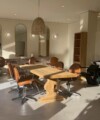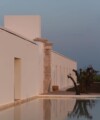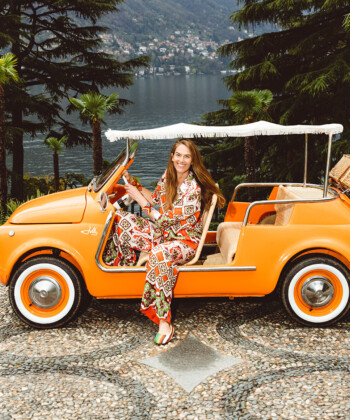“I’m lazy,” says Patrick Blanc with a laugh. The acclaimed horticulturalist-designer, who’s credited with pioneering up-down botany as an architectural feature, is anything but. On the phone from his native Paris, Blanc, who speaks near-perfect English with a thick Continental lilt, is preparing for an epic journey that will take him the following day to site meetings in New York, Taiwan, Kuala Lumpur, Hong Kong and finally to the jungles of Borneo, where he’ll spend a couple of weeks conducting research and stockpiling inspiration.
Such relentless travel has become the standard way of life for Blanc, whose verdant installations—which are otherwise referred to as “green” walls or “living” walls—can be found thriving on the façades of residential towers and in shopping malls, hotel lobbies and private homes from Dubai to Berlin. Using a network of hidden metal frames, PVC tubing and felt as a base, Blanc builds over the surfaces a textilelike composition of plants, all assiduously selected for the given site, with subtly varying hues, sizes and textures. Some of his favorite varieties include Iris japonica, Sarcococca saligna, Acorus gramineus and Asarum splendens. Standing before one of Blanc’s walls, the sensational effect can be at once vertiginous, psychedelic, soothing and exhilarating.

A view of Patrick Blanc’s installation on the Pont Max Juvénal in Aix-en-Provence, France, completed in 2008.
As a child living near the French capital, in the 1960s, Blanc developed a fascination with the interplay between flora and fauna during frequent trips with his mother and the family dog to a nearby park. There he observed many plants not rooted in soil, but thriving on rocks, beneath cascading waterfalls in fishponds. That ultimately sparked his creativity and led him to experiment with growing his own small nursery along the back wall of an aquarium in his bedroom. “What I wanted to have, actually, was the most clean, clear water possible. For this, the plant roots inside the aquarium would take out all the excess minerals and nitrogen,” he explains. And with that, the vertical garden, albeit in a formative phase, was born.
Following years of study during university in the rainforests of Southeast Asia, Blanc earned his PhD in 1978 and finally patented the vertical-garden concept in 1988, at which point his talent was recognized somewhat narrowly by the contemporary-art community. Then, in 2001, famed interior and product designer Andrée Putman commissioned Blanc, now 62, to create an installation on a colossal interior wall in Paris’ Pershing Hall hotel. With that project, his notoriety was sudden, and thus began his longtime working relationships with leading architects such as Jean Nouvel and Herzog & de Meuron.
“In my projects, this technique has opened up new possibilities, and I dream of a very large-scale implementation of these mysterious walls,” Nouvel explains of how Blanc’s vertical vegetation informed the development of his own working method. “Mysterious because Patrick Blanc researches plants that can be happy there. He works in the multiplicity of species before an ecosystem is put in place.”
Blanc credits the living world alone with informing his creative approach. “Inspiration is only from nature,” he says. “Not at all from architecture. Not at all from paintings. Not at all from readings. It’s simply from what I see in nature.”
It may come as little surprise, then, that Blanc—whose home office, lined with “a huge library” (for scientific-study purposes, instead of creative), is perched above a 20,000-liter aquarium housing some 2,000 fish—hopes that his work will heighten awareness of climate change and encourage ecological innovation, particularly in arid urban areas around the globe. “I think it’s important to show that nature can still survive even in places where we think it cannot,” he says. “We’ll become more inclined to protect true nature and not to replace it.” Speaking of unexpected and inhospitable places where he’s managed to cultivate flourishing greenspaces, Blanc, who sources local species whenever possible, points to the vertical garden he built at a parking garage in Lyon, France, and to the exterior walls of a cultural center in Saudi Arabia, where the plants he used withstand temperatures that regularly top 100 degrees.

J&T Café Banka in Bratislava.
The environmental benefits of Blanc’s installations are not only conceptual. Because of the thermic insulation effects of his vertical gardens, they naturally lower a building’s energy consumption by insulating the interior from the cold in winter and by protecting it from the heat in summer. The gardens also act like colossal air filters, absorbing polluting particles, which are slowly decomposed and mineralized by root systems and microorganisms. Nearly all of Blanc’s vertical gardens are also fed with recycled rainwater drawn from the structures’ roofs.
Among Blanc’s most famous projects is the One Central Park tower in Sydney, a mixed-use building he designed with Nouvel. The façade of the otherworldly structure, completed in 2013, features a tapestry of more than 85,000 plants, flowers and vines representing some 350 species that stretches 116 meters high, making it the world’s tallest vertical garden. Other noteworthy commissions include a soaring courtyard wall at the art-filled Istanbul town house of the Eczacıbaşı family (Turkey’s equivalent of the Mellon dynasty), an installation at the Quai Branly Museum in Paris and a poolside wall in Manhattan’s superluxe 53W53 residential tower next to MoMA. Forthcoming efforts are in such far-flung locales as Taiwan, Detroit, Denver and Hong Kong.

Oasis d’Aboukir, as seen from Rue des Petits Carreaux a year after installation, in Paris.
Asked about the future of vertical gardens, Blanc says he believes the number and scope of such installations will inevitably increase, but the medium’s widespread success will depend on new, more affordable and efficient technology. “I think in the future—in 10, 15 years—there will be more vertical gardens, but they will have to be very well managed. It gets very expensive,” he says. “But year after year, when people see that I make these extraordinary things all around the world, they think, Why should we not do the same?”






































